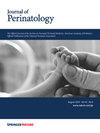Nurse and parent perspectives of a neonatal intensive care unit redesign from open-bay to single-family rooms
IF 2.4
3区 医学
Q2 OBSTETRICS & GYNECOLOGY
引用次数: 0
Abstract
To assess nurse and parent perspectives of a neonatal intensive care unit (NICU) redesign from open-bay (OPBY) to single-family rooms (SFR). We analyze interviews with NICU nurses and surveys with parents/guardians of neonates discharged from the NICU in the OPBY compared to SFR settings. The SFR design increased privacy, eased facilitation of sterile and isolation procedures, and improved perceived comfort of parent participation in breastfeeding and kangaroo, or skin-to-skin, care. Increased privacy in the SFR design also resulted in unintended consequences including limited visibility of the healthcare team and increased need for clinician-parent communication. Policies and procedures meant to keep families safe during COVID-19 further decreased parents’ perceived access to and responsiveness of the healthcare team. Supportive policies and procedures promoting increased clinician-parent communication and additional parental supports may need to accompany transitions to SFRs to realize improvements in parental assessments of quality of care.新生儿重症监护室从开舱到单户病房的重新设计的护士和家长视角。
目的:评估新生儿重症监护病房(NICU)从开放式病房(OPBY)重新设计为单家庭病房(SFR)的护士和家长观点。研究设计:我们分析了对NICU护士的访谈,以及对OPBY与SFR环境中NICU出院新生儿的父母/监护人的调查。结果:SFR设计增加了隐私性,简化了无菌和隔离程序,并提高了父母参与母乳喂养和袋鼠式或皮肤对皮肤护理的感知舒适度。SFR设计中增加的隐私性也导致了意想不到的后果,包括医疗团队的可见性受到限制,以及对临床医生与家长沟通的需求增加。旨在确保家庭在COVID-19期间安全的政策和程序进一步降低了家长对医疗团队的可及性和响应性的看法。结论:可能需要支持性政策和程序来促进临床与家长之间的沟通,以及额外的家长支持,以实现家长对护理质量评估的改善。
本文章由计算机程序翻译,如有差异,请以英文原文为准。
求助全文
约1分钟内获得全文
求助全文
来源期刊

Journal of Perinatology
医学-妇产科学
CiteScore
5.40
自引率
6.90%
发文量
284
审稿时长
3-8 weeks
期刊介绍:
The Journal of Perinatology provides members of the perinatal/neonatal healthcare team with original information pertinent to improving maternal/fetal and neonatal care. We publish peer-reviewed clinical research articles, state-of-the art reviews, comments, quality improvement reports, and letters to the editor. Articles published in the Journal of Perinatology embrace the full scope of the specialty, including clinical, professional, political, administrative and educational aspects. The Journal also explores legal and ethical issues, neonatal technology and product development.
The Journal’s audience includes all those that participate in perinatal/neonatal care, including, but not limited to neonatologists, perinatologists, perinatal epidemiologists, pediatricians and pediatric subspecialists, surgeons, neonatal and perinatal nurses, respiratory therapists, pharmacists, social workers, dieticians, speech and hearing experts, other allied health professionals, as well as subspecialists who participate in patient care including radiologists, laboratory medicine and pathologists.
 求助内容:
求助内容: 应助结果提醒方式:
应助结果提醒方式:


